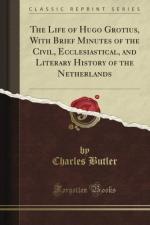The “Royal Road,” or Via Regia of Wicelius, a still more important work, was published by him at Helmstadt in 1537. Both works were approved, and the perusal of them warmly recommended, by the emperors: they have been often reprinted; they are inserted, with a life of their author, in the second volume of Brown’s Fasciculus.
“If all the divines
of those times,” says Father Simon the
oratorian,[073] “had
possessed the same spirit as Wicelius, the
affairs of religion might
have taken a different turn.”
[Sidenote: CHAP. XII.]
[Sidenote: XII.3. His Project of Religious Pacification]
Cassander, another peacemaker, mentioned with praise by Grotius, is the subject of a long and interesting article in Dupin’s Ecclesiastical History:[074]
“He was,” says Dupin, “solidly learned; and thoroughly versed in ecclesiastical antiquity and the controversies of his own times. The flaming zeal, which he had for the re-union and peace of the church, made him yield much to the Protestants, and led him to advance some propositions that were too bold. But he always kept in the communion of the Catholic church. He declared that he submitted to its judgments, and openly condemned the authors of the schism and their principal errors. He was a gentle, humble and moderate man; patient under afflictions, and entirely disinterested. In his disputes, he never returned injury for injury; and neither in his manners nor in his writings were presumption or arrogance ever discoverable. He avoided glory, honor, or wealth; and lived private and retired, having no other thought or wish, but to promote the peace of the church; no employment, but study; no business, but to compose books, which might be profitable to the public; and no passion, but knowing and teaching the truth.”
His character procured him universal respect. The emperor and several Catholic princes in Germany fixed upon him as a mediator in the religious disputes, by which the empire was, at that time, agitated. In conformity with their views he published his celebrated, “Consultatio de Articulis Religionis inter Catholicos et Protestantes Controversis.”
“In this work,” says Mr. Chalmers, “he discusses the several articles of the Augsburgh Confession, stating their difference from the doctrines of the Catholic church, and the concessions that might safely be made in respect to them. This work was written with great liberality, was much applauded by those, who were desirous of a coalition: they were too soon convinced that every attempt of this kind was nugatory. Cassander presented it to the Emperors Ferdinand I. and Maximilian II. They received it favourably; the former invited Cassander to Vienna, but his infirmities prevented his accepting the offer.”
[Sidenote: CHAP. XII.]
In 1542, Grotius published his “Road to Religious Peace,—Via ad Pacem Ecclesiasticam:” he inserted in it Cassander’s “Consultation,” and accompanied it with notes.




